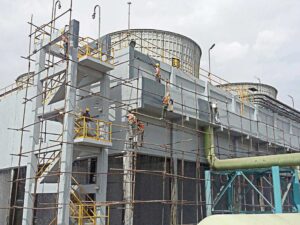Corrosion Protection and Prevention
We have established range of corrosion protection control techniques to combat corrosion and thus enhance the durability which leads to reduced future maintenance costs for the client. Steel corrosion costs astronomical every year and it is often the reason we are required to repair buildings and structures.
These techniques range from simple barrier coatings like Epoxy, Urethane and Vinyl etc, corrosion inhibitors, galvanic cathodic corrosion protection systems, hybrid cathodic protection systems also we are working on impressed current cathodic protection systems (ICCP).
The primary cause for steel corrosion in concrete is chloride ions at the steel/concrete interface in sufficient concentration to disrupt the passive film on the steel surface and initiate corrosion and eventually initiate pitting corrosion of the steel reinforcement which leads to concrete cracking and structural failure.
In steel framed buildings where the stone or masonry cladding is in intimate contact with the steel frame, any cracks in the facades or deficiencies in rainwater management will lead to steel frame corrosion and subsequent failure of the cladding system which is often termed “Regent Street Disease” where the problem is a common occurrence on buildings constructed.
At PIONEERCONSS we specialize in the design, installation and management of corrosion control techniques for reinforced concrete and steel framed buildings which stop or reduce future steel corrosion activity. Prevention is the most cost-effective way of managing the risk and we have the experience team of reputation in the industry to deliver corrosion management solutions
The primary deterioration mechanism for reinforced concrete is corrosion of the steel reinforcement. This is usually initiated by carbonation of the concrete at the depth of the reinforcement, If we can slow down the rate of movement of either of these mechanisms, coupled with a reduction in the ingress of water and oxygen, we will delay the onset of corrosion of the reinforcing, and prevent any subsequent spilling taking place.
The first step in this process is to carry out a thorough concrete condition survey which will identify the depth of carbonation and chloride ion concentration in relation to the concrete cover to the steel. This can be establish thru Modern tenancies like NDT /Moisture testing Equipment’s Etc The easiest way to do this is by applying a coating (generally termed an ‘anti-carbonation’ coating) to the concrete surface. Anti-carbonation coatings reduce the ingress of carbon dioxide, oxygen and water into the concrete.
PIONEERCONSSis well experienced and competent in the cleaning and preparation of concrete, and the application of a variety of coatings systems. These include;
- Anti-carbonation coatings
- Penetrating hydrophobic coatings (such as siloxanes and silanes)
- Migrating corrosion inhibitors
- Cementitious coatings Etc.

